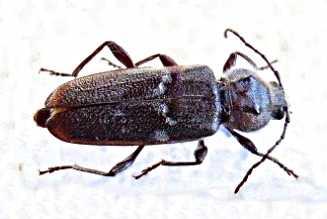

2015-05-01 Dott.sa Carla Petta posted:
Woodworms are insects that feed on wood and, more specifically, cellulose and belong to the order of Coleoptera. The woodworm's mouthparts can chew through most types of wood used by humans both in construction, and for artistic purposes. For this reason, the woodworm is also known as the common furniture beetle. The most common woodworm families are Anobiidae, Lyctinae, and Cerambycidae. Among these, the most common species in Italy are: anobiidae family: "Anobium Puntactum" (furniture beetle), and the "Xestobium Rufovillosum" (death watch beetle), Lyctinae family: "Lyctus brunneus" (powder post beetle) and cerambycidae: "Hylotrupes bajulus" (European house borer).
LIFECYCLE: The complete metamorphosis of woodworm involves three stages: the egg laid by the adult on the wood to be infested; the larva that uses its mouthparts to eat the wood, sometimes causing substantial structural / aesthetic damage, and the adult, that does not cause any damage directly, but completes the work of the larva, leaving the infested site by exit holes. The most common signs of infestation by woodworm are the presence of holes in the wood, the presence sawdust that has an appearance dependent on the type of insect, and, usually, the appearance of adult exit holes.
INTERVENTION METHODOLOGIES: Commonly fought with chemical control methods, these insects are very difficult to remove because they live in the wood and therefore achieving direct contact is a very complicated operation. For liquid insecticides, penetrative power is reduced considerably due to the fact that wood is a material that is hydrophobic and does not absorb water. This considerably limits the power of water-based insecticides, not to mention the powders and other solid forms in which the active ingredients are usually conveyed.
To definitively resolve the problem of woodworm, be it in wood beams or furniture, our company is pleased to introduce a new, innovative, and ecological system: "heat extermination". Using sophisticated electrically-powered heaters, we can apply the heat to specific points. This ensures the temperature of the areas under treatment reach between 50° and 60° (approx.) and remains constant for the time necessary to ensure total death of any pest regardless of its lifecycle stage (egg, larva, pupa, or adult). The time required for the various treatments varies from 24 to about 48 hours. The insects are killed due to the denaturing of proteins.
How much it cost?